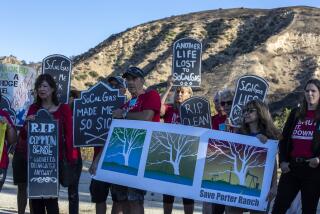State Officials Tour LNG Sites With Energy Execs
- Share via
Top Schwarzenegger administration officials have come under attack from environmental and community leaders for taking an 11-day tour of Australia and Asia in the company of oil industry executives who want to build lucrative -- and controversial -- gas terminals along the California coast.
At a time when the state is grappling with complex decisions about whether to import liquefied natural gas, three cabinet secretaries visited LNG facilities in the July trip paid for by a foundation supported by the energy industry.
Their itinerary included meals, receptions and briefings with top energy executives and Australian and South Korean government officials, but no meetings with overseas environmental groups. The 14-member delegation included executives from BHP Billiton, Calpine, ChevronTexaco, Sempra Energy, Shell and Southern California Edison, along with one representative of a California environmental group.
LNG has been an important fuel for decades in Asia, but only in the last few years have energy companies seriously explored importing it to the West Coast, causing consternation among residents who fear that such terminals could pose safety and security risks.
The LNG tour guest list included state Resources Secretary Mike Chrisman, Cal/EPA Secretary Terry Tamminen; Cabinet Secretary Marybel Batjer, representing the governor; and Joseph F. Desmond, deputy resources secretary for energy.
The trip included a stay at the Four Seasons hotel in Sydney, Australia, a yacht tour of Sydney Harbor and, for some, a trip to the Korean demilitarized zone.
Among the sites visited were the Kogas Inchon LNG terminal in South Korea, and Barrow Island, a nature reserve known as “Australia’s ark.” The island is the proposed site of a much-debated LNG undertaking known as the Gorgon Project.
Although critics dismissed the trip as a junket, several who took part said it involved grueling travel, 4 a.m. wake-up calls and late-night sessions. Chrisman called it an opportunity to visit state-of-the-art LNG facilities and to learn from the companies that run them and governments that oversee them. There are four LNG terminals in the United States, none in California.
“It’s important to put the trip in context,” Chrisman said. “It was a great primer. Talking to the people who handle this on a daily basis -- it was very helpful.”
Just days before leaving for Asia, Chrisman and Tamminen met with a number of LNG critics who had asked for the chance to raise concerns about LNG projects around the state. The 90-minute meeting took place in Sacramento.
Some of those critics, however, say the trip provided the oil companies 11 days of close contact with the very officials who will help decide the future of their projects.
“It’s just unbelievable access,” said Bill Powers, chairman of the Border Power Plant Working Group, a nonprofit group that addresses energy and environmental issues along the U.S.-Mexican border. “I can’t imagine that the state hierarchy wasn’t aware that it was going to cause some heartburn if this became public.”
The trip was organized by the California Foundation on the Environment and the Economy, a San Francisco-based nonprofit group that plans conferences and tours intended to address major issues facing the state.
The foundation board is made up largely of corporate members, along with some government, labor and environmental representatives. It is funded primarily by an array of California corporations.
The foundation’s president, Patrick F. Mason, a former AFL-CIO research economist, said the group brings together diverse members to try to resolve policy questions.
“We reach out for a variety of points of view,” he said. Mason estimated that the LNG tour cost $7,000 to $8,000 per person.
The state Political Reform Act allows public officials to accept a gift of transportation from a nonprofit foundation, exempt from gift limits, as long as the travel is related to government purpose or an issue of public policy. Both the foundation and the official must report the gift.
Nonetheless, one ethics expert said the LNG trip poses some knotty issues.
“If the government did not feel it was important enough to pay for it, then they shouldn’t have gone,” said Robert Stern, a coauthor of the Political Reform Act and president of the Center for Governmental Studies, a Los Angeles-based research group.
Even though a nonprofit group sponsored the trip, he said, “This was not the Red Cross taking them. It appears that special interests are getting special access. And things were supposed to be different under the Schwarzenegger administration.”
Douglas Heller, executive director of the Foundation for Taxpayer and Consumer Rights, agreed. “If this was an important policy trip,” he said, “the governor should have had the state pay for it, and they didn’t need to stay at the Four Seasons hotel.”
Four of the energy firms that sent executives on the tour have contributed a total of $250,000 in political funds to Schwarzenegger. Some critics of proposed LNG facilities in California are questioning why state officials met with energy executives overseas when they have not visited communities where LNG facilities are proposed in California.
BHP Billiton, an Australian firm, is seeking permission to build a terminal 23 miles offshore from Oxnard. The Oxnard City Council voted in July to oppose the project.
ChevronTexaco is exploring a possible terminal near Camp Pendleton, and is further along with plans for a terminal in Mexico’s Coronado Islands, near San Diego. Mitsubishi, which is pursuing plans for a terminal in Long Beach, was not represented on the trip.
LNG is created by chilling natural gas to minus 260 degrees, turning it into a liquid that can be transported by ship rather than pipeline. Critics say LNG is highly flammable, and that terminals should not be located near populous areas.
Oxnard Mayor Manuel Lopez said none of the cabinet secretaries on the trip have visited Oxnard to discuss LNG. “They keep talking about having an open mind. I don’t think that’s how to have an open mind -- to have people who are going to build a facility leading the trip or going on the trip,” he said.
Long Beach City Councilwoman Tonia Reyes Uranga, whose district is north of the proposed terminal, said top state officials have not visited Long Beach to discuss LNG with local leaders. “It’s the community that needs to be involved. It’s their backyard,” she said.
Chrisman, the resources secretary, said that state officials are planning a series of public workshops about LNG in communities along the coast. “We’re going to do some listening, hopefully some education,” he said.
In Australia, the leader of a key environmental group was unaware that the tour took place. “It’s disappointing that we didn’t even hear about it,” said Chris Tallentire, director of the Conservation Council of Western Australia, an umbrella organization of 67 environmental groups.
The council has spent years studying the Gorgon Project, including its potential effects on the rare species living on Barrow Island and potential release of carbon dioxide from the gas fields. The group is concerned that such releases could speed up climate change.
“Unfortunately, they will have heard only one side of the story,” Tallentire said of the California delegation. “The people they met with will have just been there to sell the project.”
Mason, of the California Foundation on the Environment and the Economy, which organized the tour, said that time limits did not allow for meetings with community and environmental groups.
“It just didn’t seem to have as much added value as talking to the government officials,” he said. Mason noted that longtime California coastal activist Susan Jordan joined the cabinet secretaries on the trip.
Tamminen, secretary of the state Environmental Protection Agency, said that the group might have benefited by meeting with Australian community groups but that California officials are just starting their research.
“Just to be honest, this was obviously intended to be the beginning of a process, not the entire process, and, therefore, it wasn’t well-rounded,” he said. “We were there to look at hardware, and, therefore, government processes.” Tamminen added, “I think people read way too much into this one trip.”
Ralph Cavanagh, a staff member of the Natural Resources Defense Council and longtime board member of the California Foundation on the Environment and the Economy, defended the trip.
“I do think there is something valuable about making California officials go out and look at things,” he said. “I don’t think it was anybody’s idea of a vacation.... There are no public funds to do something like this. If public funds were used, I can imagine the howls of outrage.”
Similar trips have been taken by past administrations, some government scholars said.
Gov. Arnold Schwarzenegger “is not doing anything different on the surface than other governors have done in recent memory,” said Jaime Regalado, executive director of the Pat Brown Institute of Public Affairs at Cal State L.A. However, “It doesn’t mean it’s so common that the government unit in question wants much media scrutiny.”
Times staff writers Patrick McGreevy and Dan Morain contributed to this report.
More to Read
Get the L.A. Times Politics newsletter
Deeply reported insights into legislation, politics and policy from Sacramento, Washington and beyond. In your inbox three times per week.
You may occasionally receive promotional content from the Los Angeles Times.










